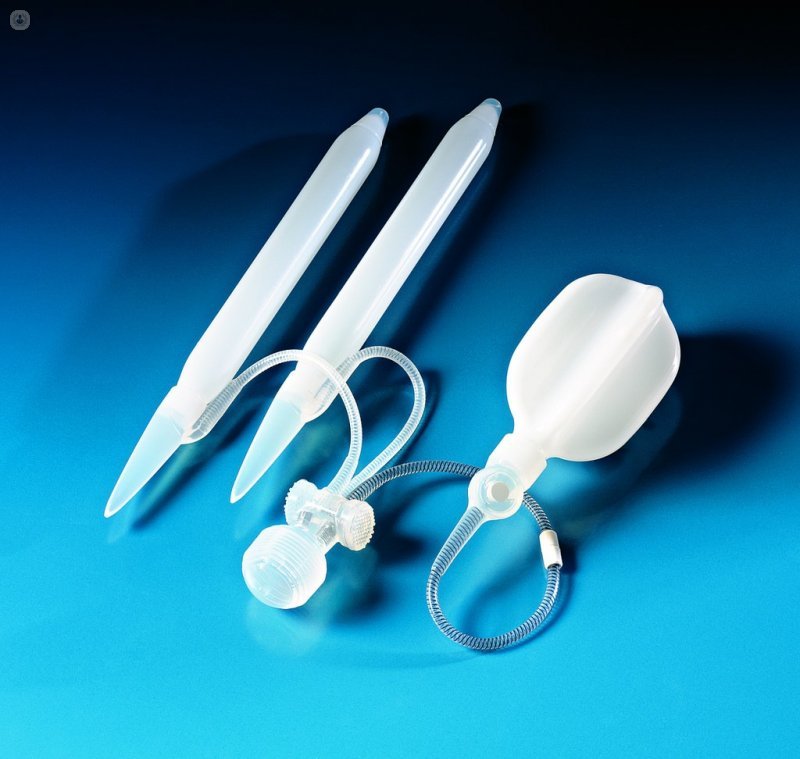Penile prosthesis:what they are and how they work ?
Written by:Prosthetic surgery of the penis consists in implanting a device inside the cavernous body of the penis. The aim of the penile prosthesis is to give the necessary rigidity to be able to maintain satisfactory sexual relations. The implant does not influence libido (desire), ejaculation or orgasm.
Initially, one of the problems that limited the expansion of these devices was their lack of reliability in the short and medium term. However, it has been decreasing as they progressed technologically until reaching rates of less than 5% in 5 years. For this reason, prostheses are guaranteed for life by some commercial houses, due to the high reliability.
We currently have a wide variety of penile prostheses. In general, they can be classified into two groups, flexible and malleable and hydraulic or inflatable prostheses:

1. Flexible and malleable prostheses
They consist of two cylinders that are placed inside each cavernous body and keep the penis rigid all the time, without causing increase in the circumference or length of it. It always maintains the same size and consistency and it is the patient who bends the prosthesis or places it in the desired position to maintain relationships.
Advantages : they have a lower cost, low incidence of mechanical failures, easier placement and shorter surgical time, which decreases the rate of infections.
Disadvantages : Continuous rigidity can cause an aesthetic problem in some patients. Occasionally, urethral examinations such as bladder endoscopy, which is necessary for the treatment and monitoring of bladder tumors, could be difficult.
2. Hydraulic prostheses
They are the prostheses of greater technological complexity. They are composed of flexible cylinders that are placed in the corpora cavernosa and are connected to a system that allows the pumping of liquid into the cylinders that are housed in the penis.. In this way an artificial erection is produced at the person's desire, also maintaining the time required.
Depending on the components that constitute the prosthesis, they are classified into two or three component devices. The two components are the cylinders that lodge in the penis and the pump that activates them that is implanted in the scrotum. The three, adds a reservoir that is implanted at the abdominal level. The latter are the most used and best considered today, given the "naturalness" they offer, both in flaccidity and erection.
Indications of a penile prosthesis
The penile prosthesis is a good therapeutic option in patients with erectile dysfunction that either do not respond to the different pharmacological treatments, or when they cause unacceptable side effects, if the erectile dysfunction is associated with La Peyronie's disease (incurvation of the penis), or when there appears penile fibrosis after priapism (unwanted and maintained erection that can produce irreversible changes in erectile tissue). That is, it is indicated in individuals affected by organic disorders when other types of treatments have failed (drugs, vacuum devices ...). In these cases it can be affirmed that the possibility of implanting a penile prosthesis constitutes a true therapeutic success of erectile dysfunction.
The implant of a penile prosthesis is an irreversible treatment. They are therefore reserved for well-informed patients, who have gone through the previous treatment steps without success, in addition to other less frequent indications. Therefore, it is very important to assess and clarify the patient's expectations before placement, because that will influence the subsequent perceived satisfaction.
It is also essential to offer this surgery only to properly selected patients and to correctly choose the prosthesis model available in the market to meet the needs of each patient.. For example, patients often have unrealistic expectations about the future length of their penis that are impossible to achieve. It is essential that the patient knows that the length of his penis after the prosthetic implant will be less than he had when he got satisfactory erections. Usually it will be similar to the one of the penis stretched in flaccidity, since the objective of the prosthesis is that the patient recovers the rigidity sufficient to be able to penetrate.
Candidates to implant a penile prosthesis should meet the following criteria of the ISSM:
- good health
- failure or contraindication of the medical treatment of erectile dysfunction.
- psychological stability
- be fully informed of the procedure and its possible complications
- signature of the informed consent of the surgery.
If these precepts are met, the penile prosthesis offers the highest satisfaction rates among treatments for ED (between 92 and 100%).


